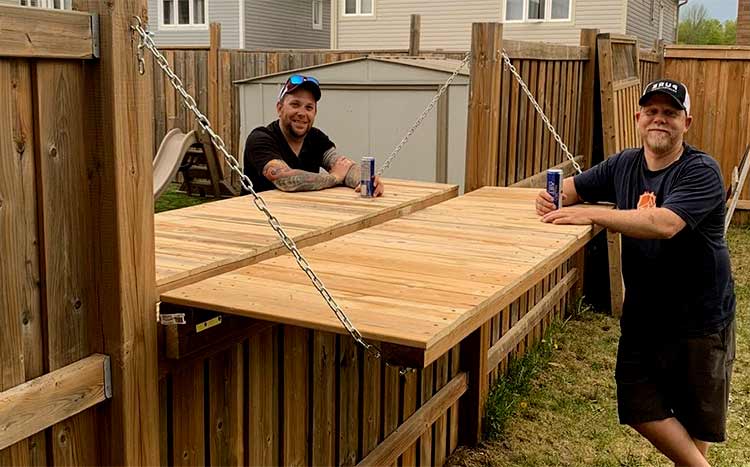Contentions regarding the expense of boundary barriers between neighbors frequently arise, especially when there’s a discrepancy in the desired design or kind of fence to be erected. These variances can escalate the friction, leading to scenarios in which one party declines to finance a fence they did not consent to. This scenario underscores a critical inquiry: who bears the responsibility for the costs linked to fencing shared by neighbors?
A fence built on a boundary line is owned and paid for by both neighbors if agreed upon before fence construction. If the fence is built within your boundary line then your neighbor is not obligated to pay.
Since the law considers boundary fences to be jointly owned by both neighbors, they typically share the cost of installing the fence equally. However, if the neighbor who is installing the fence installs it on their side of the property line, and not the boundary, the fence will be considered to be their personal property.
Here is what you should know about boundary fences.
Can my neighbor make me pay for a fence?
Yes, your neighbor can make you pay for a fence if it is a boundary fence and you are using it. According to the law, you are considered to be using the fence if:
- You are using your land right up to where the fence is located
- A fence that encloses your entire property is attached to the fence in question
- You attach another fence to the fence in question
Therefore, unless you have a way of showing that you aren’t using the fence in question, your neighbor can make you pay for the fence. This includes both the costs of installing and maintaining it.
However, your neighbor won’t be able to make you pay for the fence if they constructed it on their side of the property line. If they did so, such a fence will be considered to be private property and they can’t compel you to pay for half of it.
Who gets the good side of a fence?
While there isn’t an established law or rule dictating who should get the good side of a fence, it is always good fence etiquette to install a fence with the good side facing your neighbor’s property. And given that this is a common practice, installing your fence with the good side facing your side will simply make it look like you installed your fence the wrong way.
Furthermore, with so many fencing options and fencing styles, you don’t have to always opt for fences that have good sides and bad sides. Therefore, you can choose to install fences that have both sides finished. You can also opt for double-sided fences that are not only structurally sounder, but also look great on both sides.

Do I need my neighbor’s permission to build a fence?
No, you don’t need your neighbor’s permission to build a fence if you are building the fence on your side of the property line. Since the fence will be yours, and since you have absolute authority as far as using your land is concerned, your neighbor shouldn’t have any say as far as your decision to build a fence is concerned.
However, it is always good neighborly etiquette to inform them of your intention to build the fence. And in some cases, it can even prevent nuisance suits — remember, one doesn’t have to be on the right side of the law in order to bring a lawsuit.
Generally, it is a good idea to have your land surveyed before constructing the fence. This is especially if you don’t want to have to ask your neighbor’s permission. Doing so will help you avoid the risk of unintentionally installing it on your neighbor’s side of the property line. This is because if the fence happens to touch their property, they have a right to have it removed.
Do I need a permit to build a fence?
In most jurisdictions, you don’t need to have a permit in order to build a fence. This is because most areas have laws that exempt fences from needing a permit if the fence is:
- Under 1.8m for rear fences
- Under 1.2m for front fences
- Not near a declared street, road, or intersection
Therefore, in most areas of the country, you only need a permit if you want to build a fence that is higher than the allowed limits. If the fence that you intend to build is near a street or next to an intersection, you may also be required to seek a permit to construct any type of fence.
It is also important to note that some jurisdictions give more leeway as far as heights of fences are concerned with some placing the higher limit at 8ft for rear fences. Others place stricter height limits for fences like masonry fences.

Can I replace a fence without permission?
Yes, you can replace a boundary fence without your neighbor’s permission if the fence is built on your side of the property line. In some areas, all that you need to do to even replace a face that is built on the boundary line is simply notify your neighbor of your intention to do so.
However, since the law considers fences that are built on boundary lines to be jointly owned by the neighbors, it is always a good idea to seek their consent. This is important because it shows good faith on your part. This can go a long way toward preventing fence disputes and litigation.
What can I do if my neighbor doesn’t want a fence?
If your neighbor doesn’t want a fence, you can simply build a fence on your side of the property line. Remember, you have absolute authority as far as using your land is concerned and this includes installing a fence. Just make sure that it doesn’t touch their land because in such a case, they will have the right to both remove it and sue you.
What if my neighbor refuses to pay for a fence?
If your neighbor refuses to pay for a boundary fence, you can build the fence on your own budget and thereafter initiate mediation procedures in order to get them to pay their share of the costs of putting up the fence. And if you don’t get a resolution, you can always take them to court where you can seek to be reimbursed for half the costs.
You can also avoid the hassle of dealing with an uncooperative neighbor by simply building the fence on your side of the property. In such a case, the fence will be considered personal property and you will have total autonomy as far as the fence is concerned.
FAQ's
What’s the maximum height of a privacy fence?
The maximum height of a privacy fence that is constructed in the rear is 1.8m (just above 6 feet tall), and that of a front fence is 1.2m (just about 4 feet tall). However, you can always seek permission to build privacy fences that are higher than the prescribed height limits. In order to do so, you will have to apply for a building permit.
How much does fence installation usually cost?
While the costs of fence installations vary widely depending on the type of materials used, the height of the fence, and where it is being installed, the cost typically ranges between $1,665 and $4,062. The average cost lies at about $2,822 with most homeowners spending between $13 and $50 per linear foot.
Why is it called a ‘Stockade” fence?
The term stockade is a military term referring to prison in an army camp. This fence was called Stockade because it provides a similar kind of privacy and security as it leaves no gaps for people to peep in. Early settlers used this fence structure to secure their farms and homes.
Can I paint my side of the fence?
Boundary fences are jointly owned among owners and so yes, you can paint on your side of the fence. However, the fence was built by your neighbor, and if they built it on their side of the property line, you don’t have a right to paint it. It is private property and painting on your side of the fence will be infringing on your neighbor’s property rights.
You can always ask for your neighbor’s permission. And if they don’t grant it and you still don’t like how the fence looks, you have the option of installing your own fence right next to their fence — provided it is on your side of the property line.
Use this free tool to get in touch with a fence expert
If you need help installing a fence, or if you need clarification on the rules that apply to fences between neighbors, you should definitely visit HomeGardenGuides.com. It offers a free service that quickly matches you with the top-voted local expert fence contractors.
Using the website, you can get 3 estimates fast by real certified experts in your area in just 2 minutes. Here is how it works.
- You scroll to the top of the page and enter your Zip code.
- Answer questions about your security fence needs
- Your details will be forwarded to three local experts.
- You will then receive a price estimate for the job and some friendly advice.
IMPORTANT: There is no obligation to hire. This is a free tool and service to be used at your pleasure.






